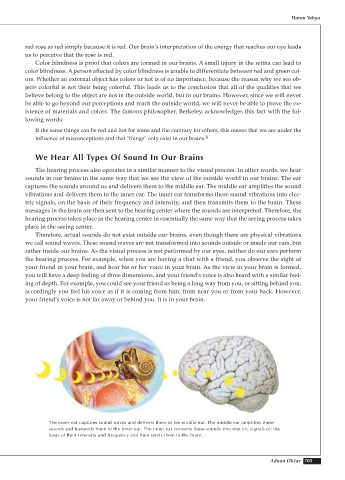Page 707 - Atlas of Creation Volume 3
P. 707
Harun Yahya
red rose as red simply because it is red. Our brain's interpretation of the energy that reaches our eye leads
us to perceive that the rose is red.
Color blindness is proof that colors are formed in our brains. A small injury in the retina can lead to
color blindness. A person affected by color blindness is unable to differentiate between red and green col-
ors. Whether an external object has colors or not is of no importance, because the reason why we see ob-
jects colorful is not their being colorful. This leads us to the conclusion that all of the qualities that we
believe belong to the object are not in the outside world, but in our brains. However, since we will never
be able to go beyond our perceptions and reach the outside world, we will never be able to prove the ex-
istence of materials and colors. The famous philosopher, Berkeley, acknowledges this fact with the fol-
lowing words:
If the same things can be red and hot for some and the contrary for others, this means that we are under the
influence of misconceptions and that "things" only exist in our brains. 8
We Hear All Types Of Sound In Our Brains
The hearing process also operates in a similar manner to the visual process. In other words, we hear
sounds in our brains in the same way that we see the view of the outside world in our brains. The ear
captures the sounds around us and delivers them to the middle ear. The middle ear amplifies the sound
vibrations and delivers them to the inner ear. The inner ear transforms these sound vibrations into elec-
tric signals, on the basis of their frequency and intensity, and then transmits them to the brain. These
messages in the brain are then sent to the hearing center where the sounds are interpreted. Therefore, the
hearing process takes place in the hearing center in essentially the same way that the seeing process takes
place in the seeing center.
Therefore, actual sounds do not exist outside our brains, even though there are physical vibrations
we call sound waves. These sound waves are not transformed into sounds outside or inside our ears, but
rather inside our brains. As the visual process is not performed by our eyes, neither do our ears perform
the hearing process. For example, when you are having a chat with a friend, you observe the sight of
your friend in your brain, and hear his or her voice in your brain. As the view in your brain is formed,
you will have a deep feeling of three dimensions, and your friend's voice is also heard with a similar feel-
ing of depth. For example, you could see your friend as being a long way from you, or sitting behind you;
accordingly you feel his voice as if it is coming from him, from near you or from your back. However,
your friend's voice is not far away or behind you. It is in your brain.
The outer ear captures sound waves and delivers them to the middle ear. The middle ear amplifies these
sounds and transmits them to the inner ear. The inner ear converts these sounds into electric signals on the
basis of their intensity and frequency and then sends them to the brain.
Adnan Oktar 705

